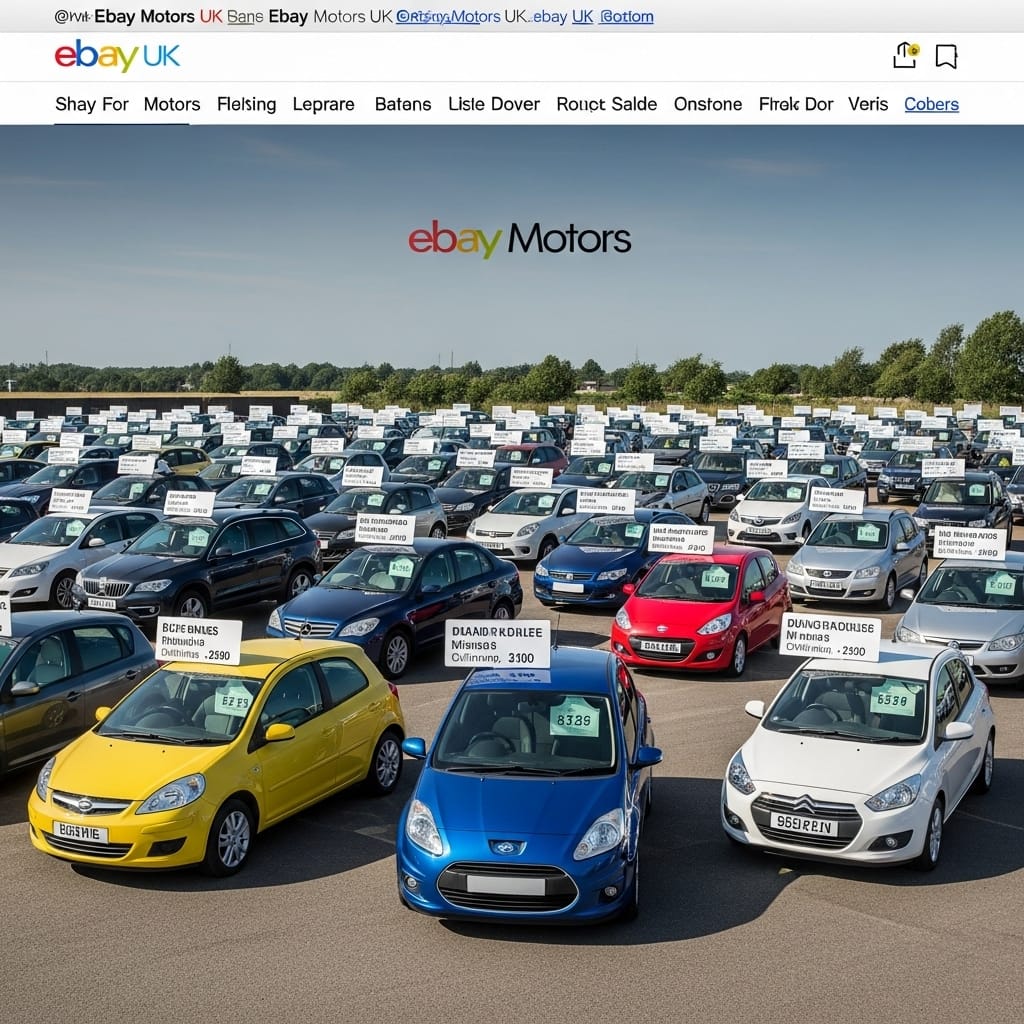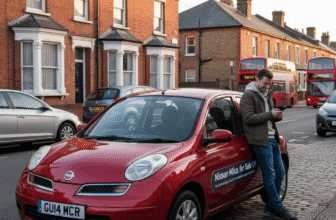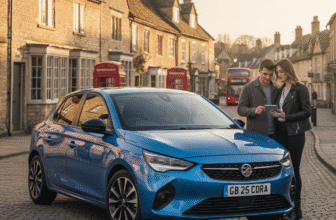
The Ultimate Guide to Buying Cars on eBay UK: From Bidding to Driving Away
In the vast, sprawling digital marketplace of the internet, few platforms command the same level of recognition as eBay. It’s a place where you can buy everything from vintage postcards to the latest tech gadgets. But what about something as significant as a car? For many, the idea of purchasing a vehicle with a click or a tap feels both thrilling and terrifying. Yet, every single day, thousands of Brits browse, bid on, and buy cars through eBay Motors UK, making it one of the largest online showrooms in the country. The question is, how do you navigate this high-stakes world of online car sales and drive away with a bargain rather than a banger?
This comprehensive guide is your roadmap to mastering eBay Motors. Whether you’re a buyer hunting for your next runaround, a dream classic, or a family workhorse, or a seller looking to get the best possible price for your current vehicle, we’ll steer you through the entire process. We’ll cover the pros, the cons, the potential pitfalls, and the essential checks you must carry out to protect yourself. Forget the daunting prospect of a blind purchase; with the right knowledge and a healthy dose of caution, eBay can be a fantastic place to find your next set of wheels.
Why Choose eBay for Your Next Car?
Before we dive into the nitty-gritty, let’s look at why you might choose eBay over a traditional dealership or a private sale down the road. The primary allure is, without a doubt, the sheer, unadulterated choice. At any given moment, there are hundreds of thousands of vehicles listed on eBay UK. From brand-new models offered by dealerships to ten-year-old hatchbacks from private sellers, and even restoration-ready classic cars that have been gathering dust in a barn – the variety is simply unparalleled. You can browse for a Ford Fiesta in Cornwall while sitting on your sofa in Glasgow. This geographical freedom opens up a national market, drastically increasing your chances of finding the exact make, model, and specification you desire.

Then there’s the potential for a bargain. The auction format, the heart and soul of eBay, can sometimes lead to incredible deals. If a seller mis-times their auction ending, or if there’s simply less interest at that particular moment, a savvy bidder can swoop in and win a car for significantly less than its forecourt value. Furthermore, private sellers on eBay don’t have the overheads of a dealership – no showroom rent, no staff salaries – which often translates into lower prices for the buyer. It’s a more direct, peer-to-peer transaction that can benefit both parties.
Navigating the eBay Motors Landscape: Auction, Buy It Now, or Classified?
When you start your search, you’ll notice vehicles are sold in a few different ways. Understanding these formats is key to your strategy.
Auctions: The Thrill of the Bid
This is the classic eBay experience. A car is listed with a starting price, and potential buyers place bids over a set period (usually 3, 7, or 10 days). The highest bidder at the end of the auction wins. Auctions are exciting and offer the best chance for a true bargain. However, they also carry risks. It’s easy to get caught up in a “bidding war” and end up paying more than you intended. A key feature to understand is the ‘reserve price’. This is a hidden minimum price set by the seller. If the bidding doesn’t reach the reserve, the car won’t sell, even to the highest bidder.
Buy It Now: The Straightforward Purchase
For those who prefer certainty over suspense, ‘Buy It Now’ (BIN) is the way to go. The seller lists the car at a fixed price, and you can buy it instantly for that amount. Many listings also include a ‘Best Offer’ option, allowing you to negotiate with the seller. This is much closer to a traditional sale. You know the price upfront, and if you’re happy with it, the car is yours. The downside is that you’re less likely to find a rock-bottom bargain compared to a no-reserve auction.
Classified Ads: The Traditional Approach Online
A Classified Ad on eBay functions much like a traditional newspaper ad, but with a vastly larger audience. The seller lists the car with a price and their contact details. There’s no bidding or online transaction. The purpose of the ad is to generate enquiries. Interested buyers then contact the seller to arrange a viewing and negotiate a price in person. This format is very common for higher-value vehicles where a physical inspection and conversation are non-negotiable. It essentially uses eBay as a powerful advertising tool to facilitate an offline sale.
A Buyer’s Guide: How to Secure Your Dream Car Safely
Buying a car on eBay is not something to be rushed. Patience and due diligence are your best friends. Follow these steps, and you’ll dramatically reduce your risk.
Step 1: Master the Art of the Search
Don’t just type “Ford Focus” and start scrolling. Use eBay’s powerful advanced search filters. You can narrow down your results by location (how far are you willing to travel?), price range, model year, mileage, fuel type, transmission, and even colour. The more specific you are, the more manageable your results will be. Set up saved searches, and eBay will email you when new cars matching your criteria are listed.
Step 2: Decode the Listing: Read Between the Lines
A car listing is a sales pitch, so learn to read it with a critical eye. A great listing will have a detailed, honest, and comprehensive description. The seller should list the good points (e.g., “Full Service History,” “New Tyres”) and the bad points (e.g., “Scuff on rear bumper,” “Air-con needs re-gassing”). Be wary of listings with very short, vague descriptions. Phrases like “Sold as seen,” “No warranty,” and “Spares or repair” are huge red flags unless you are specifically looking for a project car. Check the seller’s feedback score. A long-standing member with 100% positive feedback from selling similar items is a much safer bet than a brand-new user with zero history.
Step 3: The Golden Rule: Always Check the Vehicle’s History
This is the single most important thing you can do. For a small fee (typically £10-£20), a vehicle history check (from services like HPI Check, the AA, or the RAC) can save you from a world of pain. All you need is the car’s registration number. This check will tell you if the car:
- Has outstanding finance (if it does, the finance company could repossess it)
- Has ever been reported stolen
- Has been declared an insurance write-off (e.g., Category S for structural damage or Category N for non-structural)
- Has any mileage discrepancies that could indicate “clocking”
Never, ever agree to buy a car without running a history check first. If a seller is reluctant to provide the registration number for a check, walk away immediately.
Step 4: The Power of Pictures (and What They Might Hide)
Good sellers will provide numerous high-resolution photos from every angle: exterior, interior, engine bay, boot, and close-ups of the wheels and dashboard. Look for consistency. Do all the body panels match in colour and alignment? Uneven panel gaps can suggest a past accident. Are the interior shots clear, or are they suspiciously dark? Look at the wear on the steering wheel, gear knob, and driver’s seat – does it seem consistent with the advertised mileage? Remember that a rainy day can hide a multitude of paintwork sins, and a quick valet can make a tired interior look deceptively fresh.
Step 5: To View or Not to View? The Crucial Inspection
While the internet makes remote buying possible, we cannot recommend this enough: always try to view the car in person before you bid or buy. A car can look perfect in photos but reveal a host of problems up close. If you’re not mechanically minded, take a friend who is, or even better, pay for a professional inspection from a service like the AA or RAC. It might cost a couple of hundred pounds, but it could save you thousands. During a viewing:
- Check all the electronics work – windows, lights, radio, air-con.
- Look for any signs of rust, especially on the sills, wheel arches, and under the car.
- Check the tyres for tread depth and uneven wear.
- Inspect the engine for any obvious oil or fluid leaks.
- Take it for a test drive. Listen for any strange noises from the engine, suspension, or brakes. Does it drive in a straight line? Does the clutch feel right?
- Check the paperwork. Does the V5C logbook name and address match the seller’s? Is there a full service history?
Step 6: Sealing the Deal: Secure Payment and Collection
You’ve done your checks, you’ve won the auction or agreed on a price, and you’re ready to pay. eBay’s official policy states that for vehicles, you should not use PayPal for the full amount. PayPal’s protection doesn’t cover vehicle sales. The standard and safest practice is to pay a small deposit via PayPal (e.g., £100-£250) to secure the car, and then pay the remaining balance on collection. This final payment should be made via a bank transfer (which is instant with most UK banks) or, for smaller amounts, cash. Always get a written receipt from the seller, signed by both of you, detailing the car, the price paid, and the date. Don’t hand over the full amount until you have the keys, the V5C logbook, and are satisfied with your final inspection on collection day.
A Seller’s Guide: How to Maximise Your Car’s Value on eBay
Selling your car on eBay can be hugely rewarding, putting you in control and potentially earning you more than a part-exchange offer. Here’s how to do it right.
Step 1: Preparation is Everything
First impressions count. Before you even think about taking photos, give your car a thorough clean inside and out. A mini-valet can add hundreds of pounds to the final sale price. Wash and wax the bodywork, clean the wheels, dress the tyres, and vacuum the interior until it’s spotless. Get rid of any personal clutter. Consider fixing minor, inexpensive issues. A new set of wiper blades or touching up a stone chip shows you’ve cared for the car. Gather all your paperwork: the V5C logbook, the full service history, old MOT certificates, and receipts for any work done.
Step 2: Create the Perfect Listing
Your listing is your shop window. Start with a clear, informative title. Instead of “Ford Focus for sale,” try “2018 Ford Focus Zetec 1.0 EcoBoost | 5 Door | FSH | 35k Miles | MoT to May 2026”. In the description, be honest and detailed. Start with the basics: make, model, year, mileage, MOT expiry, number of previous owners. Then, write a narrative. Describe what it’s been like to own, its best features, and its fuel economy. Crucially, be upfront about any faults. Mention the scratch on the door or the worn tyre. Honesty builds trust and prevents issues later. A buyer who arrives to find undisclosed faults will likely walk away or try to haggle aggressively.
Step 3: A Picture is Worth a Thousand Pounds
Don’t skimp on photos. Aim for at least 20 high-quality images. Take them on a clear, dry day in a location with a neutral background – a quiet car park is better than a cluttered street. Capture every angle of the exterior, all sides of the interior, the dashboard (with the engine running to show no warning lights), the boot, and the engine bay. Most importantly, take clear photos of any damage you mentioned in the description. This proves your honesty and shows the buyer exactly what they’re bidding on.
Step 4: Price it Right and Manage the Sale
Research is key. Search for cars of the same make, model, age, and mileage on eBay and other sites to get a feel for the market value. For auctions, starting the bidding at 99p with no reserve is a brave but often effective strategy to attract a lot of interest. If you’re nervous, set a realistic starting price or use a reserve. Once the listing is live, be prepared to answer questions promptly and politely. Be accommodating to genuine viewing requests. A well-managed sale gives buyers confidence and encourages higher bids.
Step 5: The Handover
When the auction ends, contact the buyer to arrange collection and payment. As mentioned, a small PayPal deposit is fine, but insist on the balance via bank transfer or cash on collection. When the buyer arrives, let them have a final look around. Then, it’s time for the paperwork. You must complete the green ‘new keeper’ slip (V5C/2) and give it to the buyer. You are then legally responsible for telling the DVLA you’ve sold the vehicle. The quickest way is online via the GOV.UK website. You will need the 11-digit reference number from the V5C. Once the money is cleared in your account and the DVLA is notified, your responsibility ends.
Conclusion: Your Road to a Great Deal
Buying and selling cars on eBay UK is a journey that requires a different mindset to traditional methods. It demands research, patience, and a healthy dose of scepticism. For buyers, the potential to find the perfect car at a great price is very real, but it’s a reward reserved for those who do their homework. A thorough history check and an in-person viewing are not optional extras; they are essential safeguards against making a costly mistake. For sellers, the platform offers an enormous audience and the chance to achieve a true market price for your vehicle, cutting out the middleman. By presenting your car honestly and professionally, you build the trust needed to secure a successful sale.
Ultimately, whether as a buyer or a seller, success on eBay Motors comes down to one thing: diligence. Take your time, trust your instincts, and follow the steps outlined in this guide. Do that, and you might just find that the open road to your next car begins with a simple click.







